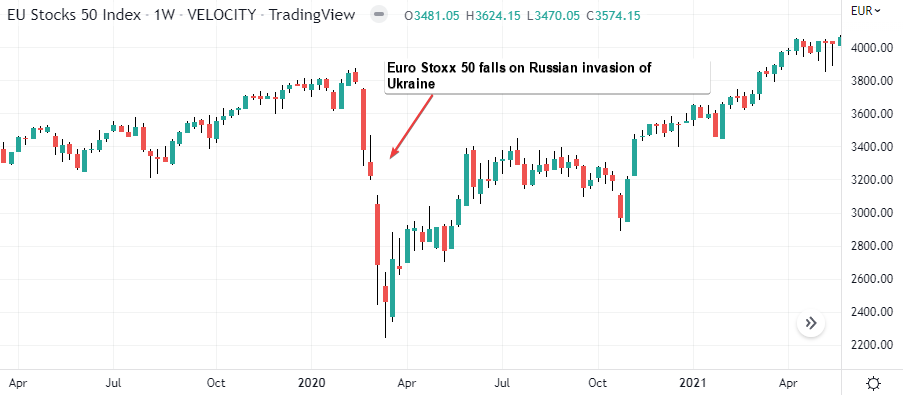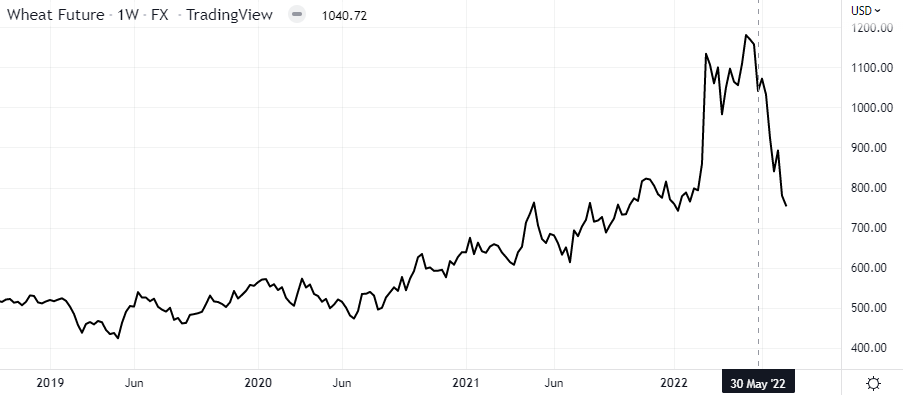With inflation being a topic of debate, both among the financial circles and at dinner tables, there are many arguments floating around. For one, the current rise in inflation did not come as a surprise. Perhaps the biggest surprise was in learning about it once the mainstream media caught on to it.
There has been evidence of building inflation pressures since the Covid era. However, thanks to unexpected events such as the Russian war on Ukraine, it only helped to serve as a catalyst. With inflation surging to record highs around the world, the big question is what led to the current circumstances.
In this article, we take a look at five big reasons responsible for the current surge in inflation. These are:
- Easy monetary policy
- Covid-19 pandemic and its impact on monetary policy
- Russia – Ukraine war
- The strength of the US dollar
- Oil prices and their impact on inflation
All these factors combine to tell a story of a perfect storm, some as a result of other factors. But by and large, happening within a short span of time. Just before the start of the current surge in inflation, the financial markets were very choppy at the start of the year.
Much of the tantrums were a result of the markets trying to adapt to what central bankers may do. In some ways, the current rise in interest rates was well anticipated and can be seen the broadly muted market reaction when a central bank hiked rates in recent weeks.
Read more about the five big factors contributing to the current inflation pressures and how we got there.
Decades of easy monetary policy
The current monetary policy is merely a consequence of past decisions. This can be traced back to the 2008 global financial crisis. Never seen before, it showed that the global markets were strongly interlinked.
Following the collapse of Lehman Brothers and many other big-name financial institutions, the global banking sector took a big hit. In a bid to revive the US economy, the Federal Reserve had to bail out some of the big banks.
But this wasn’t enough as it soon had to resort to quantitative easing, also known as “Helicopter money” during the Bernanke years. This new monetary policy tool was aimed to inject cash directly into the economy.
We saw this used during the Covid pandemic, with the US spending as much as $1.2 trillion as an aid at the height of the crisis. This comes even as the Federal Reserve hasn’t yet unwinded its previous QE-era balance sheet.
Similar stories can be seen across other major economies, with the Eurozone being a prime example. Years of low inflation have kept interest rates subdued, making borrowing easier. Consequently, a combination of various factors has led to inflation finally anchoring itself.
While under normal circumstances, higher inflation can be tamed with higher interest rates, the global economy is still not out of the woods. Thus, there is a very good chance, that with higher interest rates being the only option, the global economy may head into a deep recession.
There is a well-documented history of the impact of a sudden and sharp increase in interest rates, which tends to push an economy into a recession. However, in the current situation, central banks do not have much flexibility.
The ECB for example hiked rates by 50bps, taking the market by surprise while RBNZ hiked rates six times since October 2021.
Covid-19 disruption
The Covid-19 disruption was a total Black Swan event that the world leaders did not anticipate or prepare for. It led to global trade breaking down and also highlighted the strength or lack of it among different economies.
The Covid-19 pandemic spurred a brief recession pulling down quarterly GDP growths across all the economies. However, it was a V-shaped recovery as one would call it. By early 2022, the global economy was back on its feet.
However, it was too soon to declare victory. With nearly two years of lockdown, across different periods, many businesses had to scale down. Even the airline industry, which contributes almost 4% to global GDP or about $3.5 trillion was grounded.
It was the same story across many other businesses and economies that relied heavily on tourism and the hospitality sector. But beneath the headlines, there was a larger story brewing, which was to do with demand and the supply chain.
Although the global economy gradually recovered over the quarters, demand was not that stable. On the contrary, demand surged, making up for the lost quarters. This in turn put undue pressures on production or the supply side, causing prices to spike.
A case in point is the Palladium futures, which surged in the years after Covid peaked.

This is just an example, but given the many uses of the raw material, the higher costs for sourcing Palladium saw price increase across the board, hitting the automobile industry for example. Palladium is one of the key components of the EV market segment.
This created additional pressures for the automobile industry which already saw weakening demand due to the new “work from home” culture that started as a result of the pandemic. Similar patterns can be found across other commodity markets as well.
Russia's war on Ukraine
The Russian war on Ukraine did not come as a surprise, given the many warnings issued by the United States. Yet, when it did indeed happen, the markets were unprepared.

The above chart shows the weekly timeframe of the Eurostoxx 50 index. The Eurostoxx index is made up of the 50 biggest blue chip companies across various countries in the Eurozone. Following the news of the war, the index fell sharply, however it has recovered somewhat since then
Most of this recovery has been on the back of renewed spending from the Eurozone. The economic bloc is plagued by many issues, ranging from raising money to fund the war to its reliance on Russian gas and oil.
Furthermore, the war has globally impacted commodity prices, especially grains. With Ukraine and Russia. According to this article, a third of global wheat exports come from Russia and Ukraine which have been impacted due to the war.
This has put undue pressure on some of the most commonly used commodities including cooking oil, where Ukraine is one of the biggest global exporters. Consequently, this has led to price pressures building up as a result.
However, there should be some good news around the corner, with the latest news reports suggesting that both Ukraine and Russia have agreed to resume wheat exports. As far as the Wheat futures go, we are already seeing evidence of prices stabilizing, after peaking at highs of 1200 earlier this year.

Still, despite the current respite, the crisis in Europe has snowballed into a global inflation issue, cutting across all economies and regions. Adding to the above, the US led sanctions on Russia have also made a trade with Russia difficult, further contributing to the crisis.
The rise of the US dollar
As a global safe haven currency and the world’s reserve currency, the US dollar needs to remain stable. There are many economies, especially in Asia who are pegged to the US dollar, while many emerging market economies rely on settling trade in US dollars.
When the dollar appreciates significantly, it can cause a burden on various economies. And since a rising dollar means that countries need to spend more to buy the same quantity of goods, it has the potential to break fragile economies.
There are many financial articles that delve upon this aspect. Even if an economy is more or less self-reliant, it still needs to settle its trade in the US dollar. Given that global commodities are priced in the US dollar, it becomes a vicious circle.
A stronger dollar, on the back of higher interest rates also poses the risk of capital flight. Institutional investors are always in the search of a high yield. With the Federal Reserve on a strong monetary policy tightening path, the US dollar remains attractive.
As a result, this can reduce the FDI or foreign direct investment into an economy. In order to circumvent this rough patch, emerging economies need to have a rather large cushion of foreign currency reserves in order to meet demand.
Just over a year ago, the Bank for International Settle issued a stark warning that developing economies are at a high risk of bankruptcy. While this was in the context of the pandemic, the continued strength of the US dollar remains a worry.
Sri Lanka for example (among other issues) has already seen a major currency crisis, with Pakistan also facing fiscal issues. There are numerous examples from history which show how a strong relation to the US dollar especially for emerging markets can trigger a crisis.
Higher oil prices
It was only two years ago that oil prices crashed below 0, briefly touching a low of -$40 at the peak of the pandemic. What that essentially meant was that producers were paying consumers to offload the inventory.
We saw various shipping containers also staying afloat at sea, serving as oil storage facilities. All in all, demand for oil, often considered the lifeline of global trade plunged.

Fast forward that to the current day and we now see oil prices trading well near the $100 barrel. The brief two-year disruption caused by the pandemic saw demand surging once again. This comes as global trade picked up the pace, making for lost orders during the pandemic.
This has led to higher prices, despite efforts from US President Joe Biden to push for OPEC+ to increase production to curb the surge. However, the diplomatic efforts have not yielded much response. This is understandable given that major oil-producing nations, especially in the Middle East have felt the pinch during the covid years.
With the renewed demand for oil, the price surge has impacted the global supply chains, making the cost of transporting goods higher. In late June, OPEC+ agreed to raise production but mainly stayed the course.
This is not just because the oil-producing nations were unwilling to raise production but speculation is that they are already producing oil at full capacity. Given the direct influence oil prices have on an economy, until we see some respite from higher oil prices, inflation is likely to remain well supported.
At the same time, in order for the higher production to make an impact, there also needs to be an equal increase on the demand side. This means that there needs to be lot more consumption taking place.
Is inflation here to stay?
While it is difficult to predict accurately when inflation pressures will subside, it goes without saying that the pain of higher prices will not go away anytime soon. However, as outlined in some parts of this article, we are already seeing efforts being made to subdue inflation, at least on the commodity side of things.
The next OPEC+ meeting is due in August this year and we could see some kind of compromise be made. The biggest outlier of course remains the Russian war in Ukraine and the impact it can make in terms of continued sanctions against Russia.
The Fed is also likely to pursue its current aggressive path to hike rates, but the effects of this will take time to fan out. As a result, there is a very high chance that we may see inflation continue to rise before plateauing.
But it is not just about interest rates and geopolitics. The US dollar strength is also one to watch for. A continued rise in the dollar could potentially cause fragile economies to break, which could once again trigger panic.
While the answer to how long inflation will stay high is difficult to answer, it is evident that a recession is the most likely answer in order for the global markets to cool down in order for inflation to slow, at the very least.



